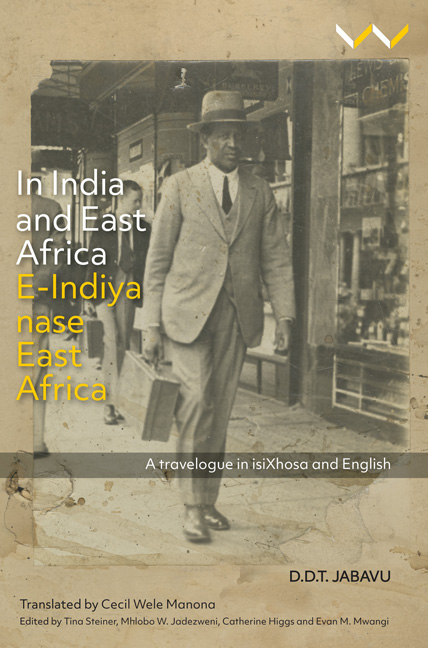Book contents
- Frontmatter
- Contents
- List of Illustrations
- Maps
- Acknowledgements
- Networks of Solidarity: D.D.T. Jabavu’s Voyage to India
- Revisiting D.D.T. Jabavu, 1885–1959
- Notes on the Original and the Translation
- In Praise of Cecil Wele Manona, 1937–2013
- E-Indiya nase East Africa
- In India and East Africa
- Afterword: Jabavu and African Translations for the Future
- References
- Editors’ Biographies
- Index
Notes on the Original and the Translation
Published online by Cambridge University Press: 27 March 2020
- Frontmatter
- Contents
- List of Illustrations
- Maps
- Acknowledgements
- Networks of Solidarity: D.D.T. Jabavu’s Voyage to India
- Revisiting D.D.T. Jabavu, 1885–1959
- Notes on the Original and the Translation
- In Praise of Cecil Wele Manona, 1937–2013
- E-Indiya nase East Africa
- In India and East Africa
- Afterword: Jabavu and African Translations for the Future
- References
- Editors’ Biographies
- Index
Summary
D.D.T. Jabavu published his travelogue in 1951 when the writing of isiXhosa was still in its infancy in terms of rules regarding the orthography. The orthography used in Jabavu's publication can be traced to the one used by John Bennie in 1826 when he pioneered the writing of this language. After John Bennie and William Govan (W.G.) Bennie, whose updated orthography was published in 1931, various practitioners of isiXhosa took to developing orthographical rules for the language which culminated in the seminal Xhosa Terminology and Orthography No.3 published in 1980 by the then Department of Education and Training in Pretoria. This great work was later revised and published in 2005 by the isiXhosa National Language Body of the Pan South African Language Board (PanSALB). The orthography of isiXhosa, like all other language orthographies, has been revised several times since then. The latest revision was done in November 2017 in Mthatha; this revision must still be verified by PanSALB. This gives a picture of the journey travelled by isiXhosa up to 2018, when the work of editing this book was undertaken.
Given the time that has passed since 1951, many people, especially younger readers, would have struggled with the original orthography used by Jabavu, and I have therefore updated it to contemporary spelling. Little did I know that one day I would have to update isiXhosa orthography in a book written by a legend like Jabavu! The last time I had anything to do with this old orthography was in the 1960s, when I attended primary school. It was quite some time ago, indeed, and hence no easy task! Not only was the orthography hard to navigate, but in addition some terms employed by Jabavu had become obsolete. In this regard, I am particularly referring to the currency used then. To adapt terms like iponti, isheleni, indaliso (pounds, shillings, pence) has been quite hard. A young student who assisted me in this task struggled greatly, as much of what she came across was very remote and strange to her.
A number of other aspects of the orthography had to be updated as well, pertaining to the spelling of the geographical names whose spelling has been corrected and updated in terms of the guidelines of the South African Geographical Names Council.
- Type
- Chapter
- Information
- In India and East Africa / E-Indiya Nase East AfricaA Travelogue in isiXhosa and English, pp. 43 - 48Publisher: Wits University PressPrint publication year: 2019



